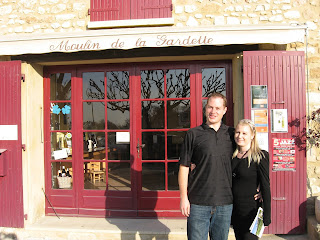Deep
in the heart of the Pfalz wine country, located just off the famous
“Weinstrasse” (wine street), a 300 year-old estate watches over the nearby vineyards in anticipation of the upcoming harvest. The Weingut Geheimer Rat Dr. von Bassermann-Jordan has created a legacy of internationally acclaimed Rieslings within a small town called Deidesheim. I was fortunate
to receive a tour and tasting at the estate with Sebastian Wandt, Sales Manager, in late August.
Our
tour started with a drive into the vineyards where Bassermann-Jordan grows their
grapes. The estate owns plots of vines within 10 "Erste Lage" (the equivalent to Premier Cru) and 10 "Grosse Lage" (Grand Cru equivalent) vineyards. This year was very hot,
with little precipitation – very similar to the 2003 growing
season. Harvest will be starting extra early this season; the week after my visit, in fact, to ensure the
grapes are at optimum ripeness and to maximize concentration in the
resulting wines.
From
there, we returned to the estate for a tasting. I was surprised to
learn that Sauvignon Blanc is gaining momentum within the Pfalz region.
Bassermann
Jordann’s Sauv Blanc is abundant with tropical fruits like
underripe pineapple and passion fruit, alongside nuances of the
traditional grassy notes towards the finish. Refreshing acidity and a clean finish make this wine perfect for those who prefer a more
fruit-forward style of Sauvignon Blanc.
A drier style of Riesling
is generally preferred within the community of the Pfalz, and this 2017 Deidesheimer Kieselberg Riesling represents this style well with racy acidity, and stony minerality mid-palate. Combined with a complex flavour profile of white peach, melon and a hint of tropical fruit, this is a must-try for anyone who
loves dry Riesling!
My
personal favourite of the tasting was the 2017 Deidesheimer Leinhole Riesling Spatlese. Incredibly fresh and clean, with ample stone fruit aromas, bright acidity and honeyed stone fruit leading into a long, lush finish. The wine is on the sweeter side as Spatlese means "Late Harvest", but not cloyingly sweet at all. This Riesling will pair extremely well with desserts like strudels and fruit pies, and is equally as delectable on its own!
From
there, we journeyed into the cellar. Built in 1822, the cellar has expanded as the
estate grew in both side and wine production. A full library containing wines of each vintage from 1880 onward is contained here, and is also fully functional with stainless steel tanks and aging racks for the winemaking process.
Bassermann-Jordan's wines are widely available internationally and through North America and offer a wide range of Rieslings that will fit your palate, as well as other varietals including Sauvignon Blanc, Spatburgunder, even Sekt! Special
thanks to Sebastian for the tour and tasting. I wish
Bassermann-Jordann a successful harvest, and a successful vintage in their wines!
Cheers!
Cheers!













